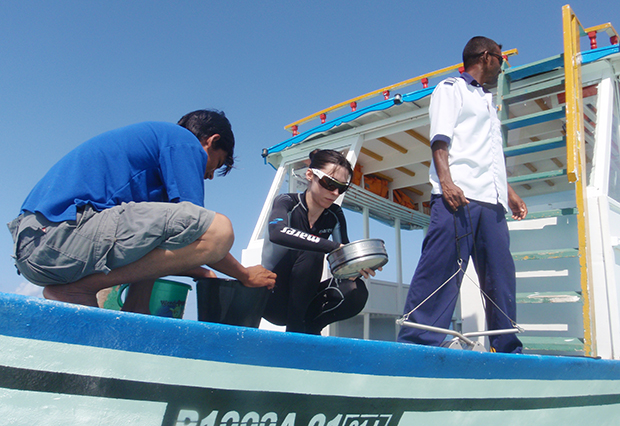
Ocean origins
EMBL alumna, Èlia Benito-Gutiérrez, on how her research and career evolved after searching the seas

For Archimedes, the eureka moment came as he took a bath. For EMBL alumna Èlia Benito-Gutiérrez, the bath was a little bigger: she was on a boat in the Indian Ocean. Under the burning midday sun, Benito-Gutiérrez focused her portable microscope on the bizarre-looking creature again. From the asymmetrical egg pouch, the striped spine-like structure running like a stack of coins along its length, and the ever-intriguing mouth tentacles, it seemed that she had discovered the mythical Epigonichthys. Lost for more than 100 years, this elusive animal has still not been formally described. Yet its rediscovery is proving vital for evolutionary biology research and has made a major impact on Benito-Gutiérrez’s academic career.
Back in time

Benito-Gutiérrez’s journey began while working at EMBL Heidelberg as a postdoctoral fellow in the Arendt group. During this time, she discovered a manuscript from 1893 that pinpointed the last known location of a species in the Indian Ocean called Epigonichthys – an elusive sea creature with an aptitude for hiding.
Epigonichthys belongs to a group of organisms known as cephalochordates – small marine animals that burrow in the sand under the sea. At first glance, they look like a cross between a fish and a worm and, in a sense, they are. They don’t have a backbone, so can’t be classed as vertebrates, yet their notochord – a structure made of a substance similar to cartilage, which runs the length of their thin bodies – distinctly separates them from invertebrates. This notochord can be described as a primitive backbone. In cephalochordates, it acts like a spine, sending out simple nerve signals and supporting the body’s structure. It also transiently exists in human embryos, acting to organise and develop our skull, spine and parts of the brain, but is broken down shortly before birth.
The notochord provides an important evolutionary link between cephalochordates and humans. It represents the transitional period in evolutionary biology during which vertebrates and non-vertebrates split into separate groups. Because cephalochordates have changed very little in millions of years, they’re an excellent model system to study – not only for this physical characteristic, but also for their genome.
Cephalochordates have the potential to unlock some of the mysteries surrounding human origins and evolution
Although Epigonichthys was discovered more than 100 years ago, it has never been described in detail. To confuse matters further, the name Epigonichthys has often been used interchangeably with another name, Asymmetron, making it unclear if the literature is always referring to the same animal. “One of our aims, when we first went to the Maldives, was to find uncharacterised cephalochordates such as Epigonichthys and describe their physical characteristics, as well as explore the information that their genomes were hiding,” says Benito-Gutiérrez. With the advancement of different sequencing techniques, these genomic secrets can finally come to light. They have the potential to unlock some of the mysteries surrounding human origins and evolution.
Searching the sand
With this in mind, it’s easier to appreciate why Benito-Gutiérrez travelled thousands of miles and braved searing temperatures to search for the cephalochordates. “Each day we sailed for three hours in a traditional Maldivian boat called a ‘dhoni’ to reach the quiet atolls,” she explains. These secluded lagoons, enclosed by coral banks and surrounded by miles of choppy ocean, require great skill to navigate. The local sailors, however, were happy to help. “They’re amazing people,” says Benito-Gutiérrez. “They were completely fascinated to hear that they were so close to these living fossils. I learned afterwards that they were having so much fun searching with us, that they ended up doing a kind of lottery each day to decide who would sail us out!”

Indeed, Benito-Gutiérrez went out on the boats many times, at both day and night. Upon arrival at their chosen locations, she and the crew used handheld grabbing tools to reach into the water and carefully collect sand from the sea bed. They then sieved it in search of their live treasure. “In the beginning, we couldn’t find anything,” says Benito-Gutiérrez. “It was very frustrating.” In fact, they sailed to 22 different GPS points before discovering Epigonichthys. “When I first saw it, I thought that, yes, this looks like a cephalochordate,” she explains, “but there were distinct differences that made me realise this was something new. It was incredibly exciting.” Yet considering how difficult it was to find these creatures, their journey back to Heidelberg was relatively smooth. The Tara Oceans team scheduled a stop to collect the samples and bring them back to EMBL, alive and well.
Tree of life
It wasn’t until Benito-Gutiérrez had the creatures in the lab that she began to realise how much potential this project had. “I set up the lab at EMBL and looked after the animals myself,” she says. “We started sequencing the Epigonichthys genome there, but after a while the project just became too much for one person to manage.” Subsequently, in 2015, Benito-Gutiérrez’s career itself evolved as she made the move from postdoctoral fellow to group leader at the University of Cambridge. “It’s been an intense time these last couple of years! But this exciting research is one of the reasons I wanted to set up my own lab.”

Now Benito-Gutiérrez’s lab houses a giant living ecosystem, which she and a dedicated team care for. “We can study and compare the genomes of three types of cephalochordates, which is something not many other groups can claim,” she explains. “We’re quite sure that they share a close common ancestor. What we’re currently unsure about is which cephalochordate is most ‘basal’ – the one that has remained most similar to the common ancestor.” With the research carried out by Benito-Gutiérrez and her team, it might be time for a complete reconstruction of the way cephalochordates are classified.
Unravelling the genome
This research might even provide insights into our own DNA, as it is likely that our genome has evolved from that of ancestral cephalochordates. “By sequencing the human genome, we’re only seeing the end product,” explains Benito-Gutiérrez. “If we understand the origin of our genome, we can better understand how our current genome works.” For example, duplicate versions of our genes have arisen during evolution and taken up different locations within our genome. Similar duplications and gene rearrangements can occur in cancer, indicating that parallel mechanisms could be at play.
If we understand the origin of our genome, we can better understand how our current genome works
The current plan for Benito-Gutiérrez is to continue researching this unusual creature and its hugely informative genome. As well as discovering more about the origins of the human genome and how it can go wrong, she hopes that confusions about the classification of cephalochordates, which have arisen over the past century, can also be unpicked. “There’s so much still to find out,” says Benito-Gutiérrez. “I don’t think the mystery surrounding Epigonichthys is solved just yet.”


